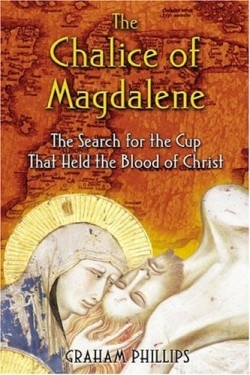The Chalice of Magdalene
The Search for the Cup That Held the Blood of Christ
“The Grail has occupied a unique place in the Western imagination since the dawn of the Middle Ages,” writes the author. “The Grail embodies a promise of immortality and the fulfillment of dreams and aspirations.”
This book is not for readers who prefer to keep the mystery in their myths and romances. The author, a best-selling non-fiction author and historical investigator who has researched such historical mysteries as Shakespeare, King Arthur, and Robin Hood, now turns his attentions to his own personal search for an actual Holy Grail. He combines a broad historical perspective that spans from early Rome through the medieval period of Britain to contemporary times, with the most current technological advances in geophysics, along with a Sherlock Holmesian attention to deductive details, to lead the reader on this quest through a labyrinth of time and space.
The book is divided into two parts. The first part is a reiteration of research done for the author’s earlier book, King Arthur—The True Story, and includes clues from the Arthurian romances and historical manuscripts that finally led to a geophysical search for the supposed grave of Arthur. Having thus established the existence of a historical King Arthur, the author deduces that the stories of the Holy Grail, almost always linked to Arthur and his descendants, must also lead to an historical Grail.
To find his Grail, Phillips follows the threads of British and Catholic history, as well as clues from both the Tarot and the Biblical book of Psalms. He claims to have finally located the Grail-a green, onyx cup the size of an eggcup-now residing with a twenty-four-year old graphic artist who is a direct descendant of the historical King Arthur.
Though the author admits that this cup may never be proved to be the cup of age-old Grail romances, as it cannot be carbon-dated, he appears to feel satisfied with what he believes to be the solution to the mystery of the origin of the romances.
“They appear to have originated with a story written around 1100,” he writes, “an allegory concerning an ostracized Christian sect, descendants of the Gnostics who claimed spiritual authority via an alternative apostolic line of succession.”
Following the author’s path through history would have been easier had the author included more detailed maps at the beginning of the book showing and comparing the different periods of time and locations in Britain. A genealogical tree of the line of Arthur would also have been helpful. Nevertheless, for those who love a good historical puzzle or mystery, this book provides thought-provoking reading.
Disclosure: This article is not an endorsement, but a review. The publisher of this book provided free copies of the book to have their book reviewed by a professional reviewer. No fee was paid by the publisher for this review. Foreword Reviews only recommends books that we love. Foreword Magazine, Inc. is disclosing this in accordance with the Federal Trade Commission’s 16 CFR, Part 255.

